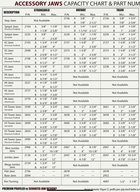Hi All,
Fairly new turner here, grinders and small boxes mostly, but I've been putting in some serious time with bowls also. I am using the twice-turned method and have been having reasonable success, but I recently made the decision to switch from my swept-back grind to the 40/40 grind and I'm wondering if anyone has tips/tricks/secrets as to how to get a clean pass on the outside of bowl on the second turning...
Once the bowl has dried and come out of my kiln, I friction-mount it using my Oneway vacuum chuck as a drive (just using the friction of the neoprene, not engaging the vacuum), and the tailstock for support. I would normally true the original tenon and then complete the outside of the bowl before remounting it with the trued-up tenon to finish the inside. Last step is to use the vacuum chuck to finish the bottom. The issue now is that I can't get the 40/40 to swing far enough to make the finish cut from the bottom of the bowl because of the tailstock. All of the videos I've watched show how to make the cut when the bowl is mounted from the rim - either by a tenon prior to hollowing, or by a jamb chuck after, using a lot of real estate over/beyond the lathe bed.
Should I consider using my bottom bowl gouge to get the first part of the curve on the outside of the bottom and then switch to the 40/40? Or is there another alternative I'm just not considering? I suppose I could try to mount the warped original tenon first and true the inside, but that forces me to use a custom jamb chuck to turn the outside for every bowl (not to mention the risk of a sloppy grip on a bad tenon) - something I'd like to avoid if at all possible. I could also use the hot-melt glue block, but that also adds an additional step and every step I can avoid is more time saved and more money in my pocket. I could true the tenon first, then remount the bowl to do the inside, and then jamb chuck it, but that also adds steps as well as the risk of not running true between mountings.
Any ideas/suggestions are welcome, and if anyone can point me to a video that might show this issue - please do! Although I'm pretty sure I've been to the end of the internet and watched every turning video out there... just ask my wife!!
Thanks for your time!
John
Fairly new turner here, grinders and small boxes mostly, but I've been putting in some serious time with bowls also. I am using the twice-turned method and have been having reasonable success, but I recently made the decision to switch from my swept-back grind to the 40/40 grind and I'm wondering if anyone has tips/tricks/secrets as to how to get a clean pass on the outside of bowl on the second turning...
Once the bowl has dried and come out of my kiln, I friction-mount it using my Oneway vacuum chuck as a drive (just using the friction of the neoprene, not engaging the vacuum), and the tailstock for support. I would normally true the original tenon and then complete the outside of the bowl before remounting it with the trued-up tenon to finish the inside. Last step is to use the vacuum chuck to finish the bottom. The issue now is that I can't get the 40/40 to swing far enough to make the finish cut from the bottom of the bowl because of the tailstock. All of the videos I've watched show how to make the cut when the bowl is mounted from the rim - either by a tenon prior to hollowing, or by a jamb chuck after, using a lot of real estate over/beyond the lathe bed.
Should I consider using my bottom bowl gouge to get the first part of the curve on the outside of the bottom and then switch to the 40/40? Or is there another alternative I'm just not considering? I suppose I could try to mount the warped original tenon first and true the inside, but that forces me to use a custom jamb chuck to turn the outside for every bowl (not to mention the risk of a sloppy grip on a bad tenon) - something I'd like to avoid if at all possible. I could also use the hot-melt glue block, but that also adds an additional step and every step I can avoid is more time saved and more money in my pocket. I could true the tenon first, then remount the bowl to do the inside, and then jamb chuck it, but that also adds steps as well as the risk of not running true between mountings.
Any ideas/suggestions are welcome, and if anyone can point me to a video that might show this issue - please do! Although I'm pretty sure I've been to the end of the internet and watched every turning video out there... just ask my wife!!
Thanks for your time!
John

